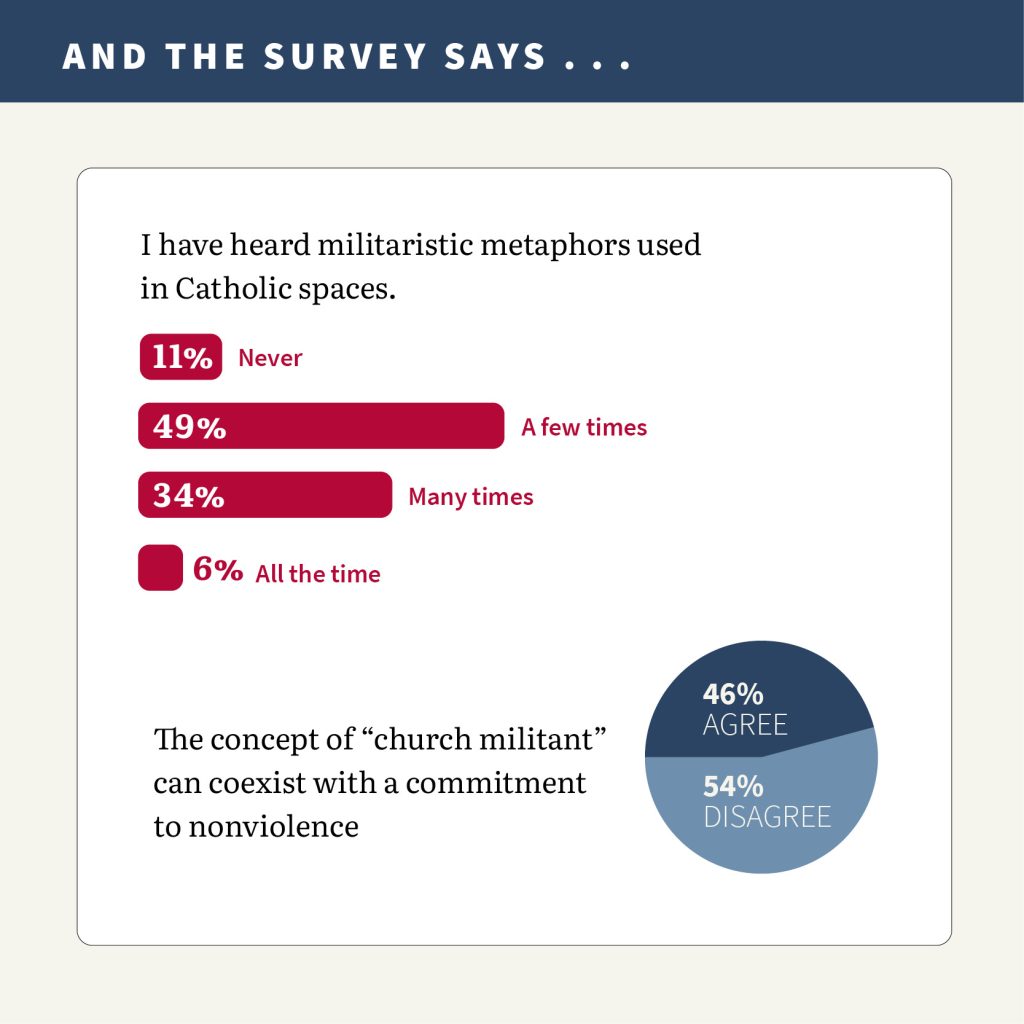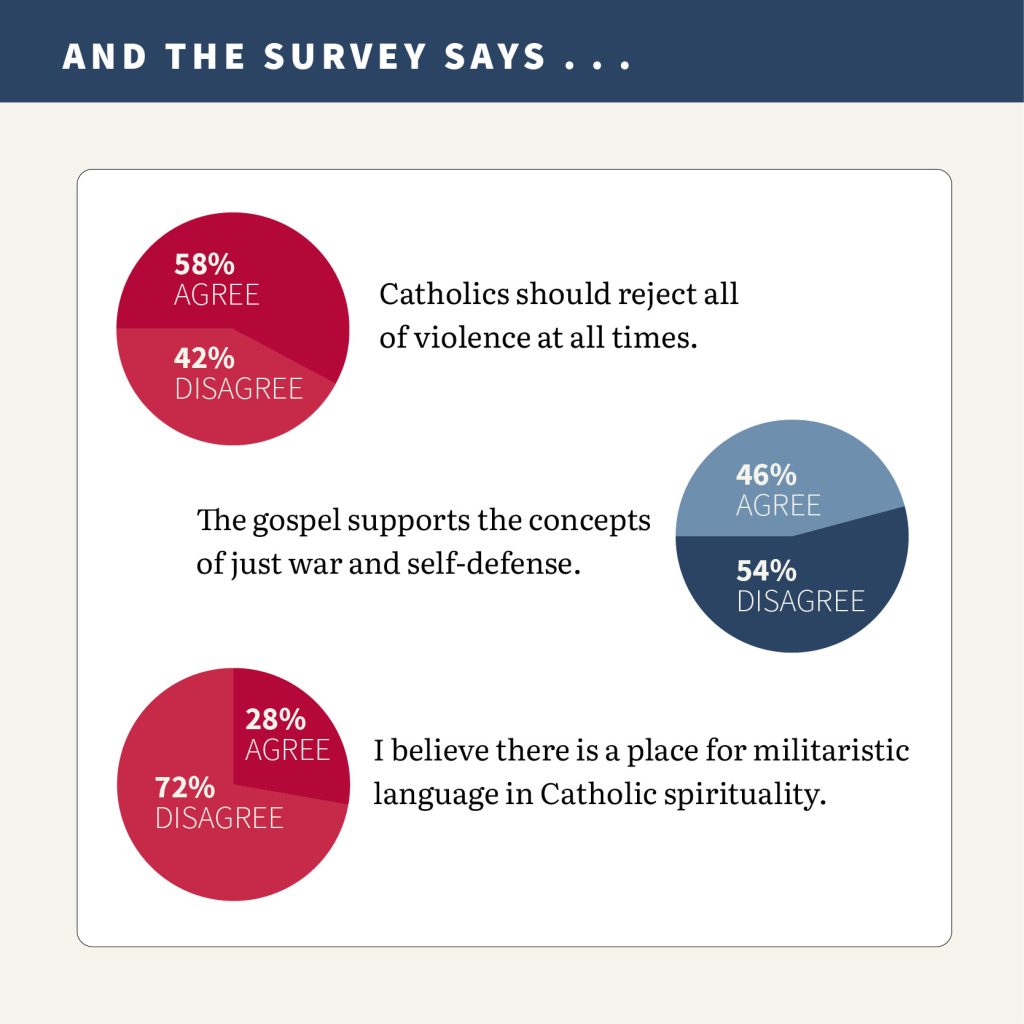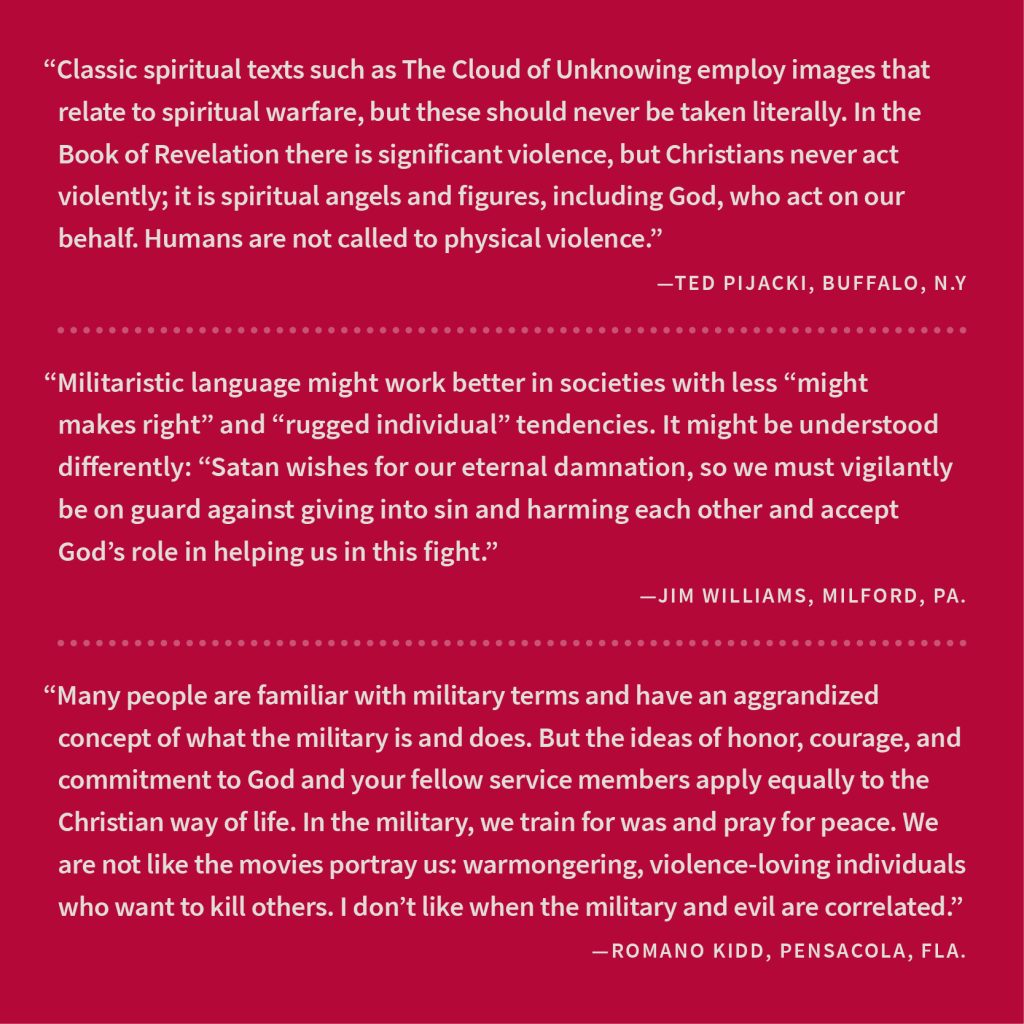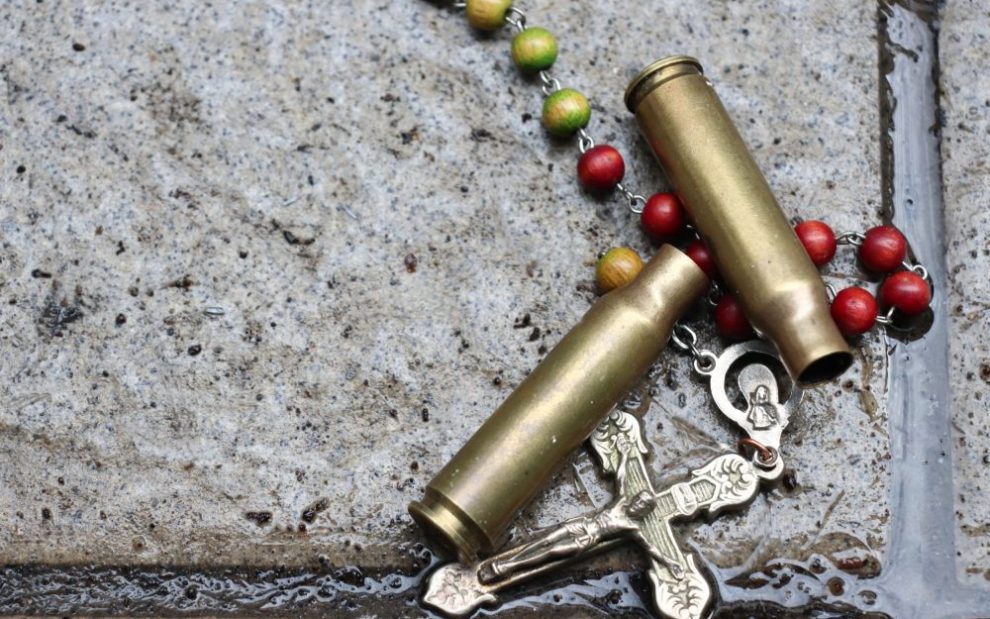Sounding Board is one person’s take on a many-sided subject and does not necessarily reflect the opinions of U.S. Catholic, its editors, or the Claretians. Results are based on survey responses from 175 uscatholic.org visitors.

God and guns, religion and violence. That marriage is as American as manifest destiny and apple pie. But is that relationship also “Catholic”? Can it remain faithful to the way of Jesus while simultaneously being meaningful and healing in the contemporary context?
In the past decade, some streams of U.S. Catholicism seem to be reembracing a connection between God and violence. For example, some parishes bless personal firearms, and some homilies and ministries are molded around a crusading us-versus-them mentality.
With Catholic holy objects, this can take a strange form. Online, for example, you can easily buy something called a “combat rosary,” intended “for heroes,” namely police, military, and first responders. The combat rosary is made of steel, features a gunmetal finish, and is patterned on a 1916 pull-chain rosary issued by the U.S. government during World War I. Its purpose is to be a spiritual weapon in the hands of those on the front lines against forces often deemed violent and evil.
On the one hand, there’s nothing wrong with reminding the faithful, including people embedded in institutions that deem violence a morally acceptable way to preserve social safety, that God’s presence is indeed with them. We Catholics often need tangible holy objects—even perhaps a hypermasculine combat rosary—to remind us of the divine presence and to help us focus on God’s love, which is always already with us. On the other hand, the tricky part is to remind people God is with them without also glorifying violence and sanctifying the tools designed to tear apart the tissue that connects and sustains life. The God who loves us and who is revealed in Jesus is indeed a triune God of life, healing, and nonviolence.
To strike this difficult balance, a specific Catholic term needs revisiting: the church militant. Oftentimes, unfortunately, this term implies that righteous Catholic violence is necessary to protect against evil non-Catholic aggression. Thinking of the church as “militant” can sanitize and romanticize the Crusades, misinterpret some of the “hard sayings” of Jesus, and glorify tools of violence like assault weapons. The same term reinforced the colonial Catholic understanding of Christendom, in which Europe was the center and epitome of Christian civilization that then, because of the Great Commission, had to be extended to all lands and peoples by any means necessary.
This is a fundamental misunderstanding of the church militant for two reasons. First, theological context matters. Catholic tradition understands that there are three states of the church: penitent, triumphant, and militant. All three pertain to the united body of Christ across space and time. Penitent describes people in purgatory; triumphant applies to people in the ultimate glory of the resurrection and beatific vision; and militant refers to people navigating their communal life here and now amid sin, grace, weal, and woe—all the ambiguity and challenges of a broken and wounded world.
Second, translation matters. The phrase in Latin is ecclesia militans. Regarding the first word, Latin adopted the Greek word ekklesia, which became the foundation for the English word church. In all three languages, it retains the meaning of a “group of people called out from society for a specific purpose.” The second word, militans, comes from the Latin root milita; while the word obviously carries a militaristic connotation, it doesn’t necessarily equate with domination and violence. In modern-day English, militant has additional connotations that include service, vigilance, zealousness, discipline, and working toward a shared goal for the common good. It is this compassionate sense of militant—disciplined love in struggling service to others as part of a beloved community—that is missing in some recent retrievals of this ancient term.
St. Pope John Paul II replaced the term church militant with a more appropriate term: pilgrims on earth, and this is also the term the Catechism of the Catholic Church uses. Still, for Catholics looking for language to empower them to grow in Christ-like love, the word militant may be a useful tool—but only if it is intertwined with a simultaneous retrieval of Christian nonviolence. Nonviolence is the standard we need to hold in the 21st century.

To this end, we Catholics need to remain a “both/and” people who can hold together in tension the light and the darkness, the grace and the sin, the healing and the harm, for all coexist in our tradition. Jesus, for example, at the Last Supper told his disciples, “And the one who has no sword must sell his cloak and buy one”(Luke 22:36)—and then, a few hours later, he unequivocally rebuked his disciples for actually using a sword to protect him (Luke 22:49–51). By the same token, Constantine saved Christians from possible annihilation by the Roman Empire—and he also militarized Christianity in a harmful way that has led to millennia of human wreckage. St. Augustine taught about “just war” and legitimate self-defense—and meanwhile, many of his contemporaries were pacifists, referring to themselves as “soldiers of Christ” only in the sense that they were engaged in the battle against sin and evil.
So what are we to conclude from all this when it comes to our own lives? Cesar Chavez, the Chicano Catholic prophet of nonviolence, offers us a way forward. He reminds Catholics that “militant” and “nonviolence” can indeed go together. Nonviolence is a way of engaging in conflict and struggle in order to transform the deepest dynamics of a conflict from harm to healing. It seeks to transfigure the very nature of the conflicted relationships so that violence no longer is possible. As Chavez observes:
In some instances nonviolence requires more militancy than violence. Nonviolence forces you to abandon the shortcut, in trying to make a change in the social order. Violence, the shortcut, is the trap people fall into when they begin to feel that it is the only way to attain their goal.
Following the example of Chavez, as well as other Catholic luminaries such as Dorothy Day, Peter Maurin, and Thomas Merton, not to mention our ecumenical siblings such as the Rev. Martin Luther King Jr. and Fannie Lou Hamer, the discipline of nonviolence includes recognizing and attuning to the movements of God’s compassionate presence among us. We need this especially now, when so much division, distrust, vitriol, and violence abound both locally and globally.
Struggle and trouble in this world—within our souls, in our relationships with others, and conferred by our social locations—are facts of Christian life. But the way we enter into this struggle matters. We are militant (in the sense that we are scrupulous, energetic, and unswerving) in our commitment to attend to the wounds and break the chains that limit the lives of some members of our human community. We attend to the Spirit’s invitation to become the “field hospital” envisioned by Pope Francis.
Nonviolence can be to contemporary Christianity what fluidity is to water: simply the way it exists and moves in the world. Or, more accurately, it is the way Christianity could exist and should move in the world, as a fully nonviolent church militant.

This article also appears in the May 2024 issue of U.S. Catholic (Vol. 89, No. 6, pages 31-35). Click here to subscribe to the magazine.
Image: iStock












Add comment